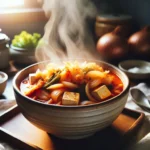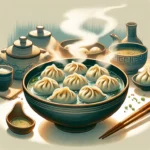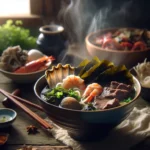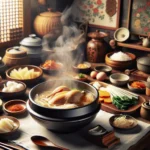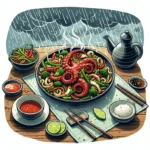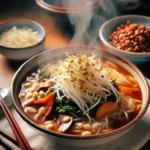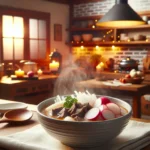Immerse yourself in the vibrant flavors of Korea with the delightful dish known as Honghap Tang, a savory mussel soup that warms both the body and soul. Picture plump, tender mussels simmering in a fragrant, broth infused with aromatic spices, transforming your kitchen into a haven of culinary exploration. As we guide you through this recipe, you’ll discover not only the essential ingredients but also the artistry behind each step. Unleash your inner chef and prepare to indulge in a bowl of comfort that carries the spirit of Korean tradition, inviting you to savor every bite.

Ingredients You’ll Need for Honghap Tang
To embark on your culinary adventure in crafting the delectable Honghap Tang, a few key ingredients will play a pivotal role in awakening your taste buds and filling your kitchen with delightful aromas. This savory Korean mussel soup is not just a meal; it’s an experience that showcases the ocean’s bounty! So, get ready to gather these essential components:
- Fresh Black Mussels: Approximately 1 kilogram of fresh black mussels is required! Make sure they are thoroughly cleaned, as they are the star of this dish. 🌊 The mussels should be firm and tightly closed; any that are open must be tapped gently – if they do not close, discard them!
- Water: Around 6 cups of water will suffice to create a rich broth that purges the mussels’ natural flavors! It’s the canvas for all the other ingredients to blend beautifully.
- Garlic: You will want about 5 to 6 cloves of minced garlic to enhance the aromatic profile of the soup. Garlic not only adds depth but also a touch of warmth to the overall flavor.
- Green Onions: Two to three green onions, finely chopped, bring freshness to the dish! Their vibrant green color is also visually appealing. 🌱
- Ginger: A 1-inch piece of fresh ginger, minced or sliced, complements the seafood aesthetic perfectly! It adds a zing that balances the richness of the mussels.
- Korean Red Pepper Flakes (Gochugaru): About 1-2 tablespoons will give the soup its signature heat! Adjust according to your spice preference; it’s the magic ingredient that adds both color and flavor. 🌶️
- Soy Sauce: 2 tablespoons of soy sauce will melt into the broth, giving it a savory umami taste that is so integral to Korean cuisine. Opt for low-sodium soy sauce if you’re mindful of salt intake!
- Sesame Oil: Just a teaspoon drizzled in at the end brings a nutty aroma to the soup that is simply unforgettable! It acts as a finishing touch that elevates the flavors. 🌟
- Salt and Pepper: Lastly, season to taste – perhaps a teaspoon of salt and a pinch of black pepper will round out the flavors just perfectly! Don’t be afraid to adjust these based on your palate – cooking is artistry! 🎨
Optional Enhancements:
- Tofu: For a heartier feel, consider adding some cubed silken tofu! Just gentle simmer it along with the mussels for a comforting texture.
- Vegetables: You can include chopped mushrooms or spinach for extra nutrition and color! A handful of seaweed can also provide a beautiful touch reminiscent of the ocean. 🥬
Having gathered all these ingredients, you are poised to create an extraordinary bowl of Honghap Tang that will certainly captivate anyone fortunate enough to enjoy it. Embrace each ingredient, for they are more than just items on a list—they represent the essence of Korean culinary tradition!
Step-by-Step Cooking Instructions
Creating a traditional dish like Honghap Tang is a journey that combines vibrant flavors and delightful textures, leading you to an authentic Korean experience! The process itself can be quite therapeutic, so let’s dive into the mesmerizing world of mussel soup, shall we?
1. Prepare the Mussels
First, start with about 1 kilogram of fresh mussels. Rinse them thoroughly under cold water. Remove any beards (the stringy part) and ensure that the shells are closed tightly. Discard any open shells that do not close when tapped; these are likely dead and not suitable for consumption.
2. Chop Your Ingredients
While the mussels are soaking, take the time to chop 1 medium-sized onion, 2 cloves of garlic, and 1-2 green chilies for a spicy kick! 🥴 You can adjust the amount of spice according to your preference. Fresh ingredients elevate the dish, bringing out the umami flavors beautifully!
3. Creating the Broth
In a pot, heat about 1 tablespoon of sesame oil over medium heat. Add the chopped onions and sauté them until they become translucent, around 3-5 minutes. Then, introduce the minced garlic and sliced green chilies, stirring for an additional minute to release their aromatic essence. ❤️
4. Infuse with Flavor
Next, pour in 4 cups of water or fish stock. For people who appreciate depth in flavors, adding 1 tablespoon of soy sauce will elevate your broth! If you’re feeling creative, a small piece of kelp (about 10 cm) can be added for an extra layer of flavor. Bring the mixture to a simmer.
5. Let’s Add the Mussels
Once the broth is simmering, it’s time to add your beautiful, cleaned mussels! Cover the pot and allow them to steam for about 5-7 minutes. Listen closely—when the mussels open up, they reveal their sweet treasure inside. Discard any mussels that remain closed; they are past their prime! ⏳
6. Finish with Freshness
After the mussels have opened, finish with a generous sprinkle of freshly chopped green onions and a drizzle of sesame oil to add a final touch of flair. For those who enjoy a bit more heat, feel free to toss in some extra chili flakes! 🌶️
7. Serving the Soup
Carefully ladle the aromatic soup into bowls, ensuring each serving gets a generous portion of mussels. Garnish with a slice of lemon or lime on the side; the acidity complements the dish perfectly. 🍋 Consider pairing your soup with a side of rice, which can balance the flavors and make for a satisfying meal!
8. Enjoy the Experience
The final step is simple yet essential—savor every spoonful of your homemade Honghap Tang! As you take each bite, note the harmony of flavors and the warmth radiating from the bowl. 🌈 Such a rewarding experience!
Cooking is not just about following instructions; it’s about creating something wonderful, something memorable. Embracing each step, from preparation to serving, enriches the overall experience and transforms your kitchen into a haven of mouthwatering aromas. So, roll up your sleeves and let the creativity flow! 🥳
Tips for Perfecting Your Soup
Creating the ultimate Honghap Tang is an art, and there are several secrets to elevate its taste and presentation! 🌊✨ First and foremost, selecting the freshest mussels is crucial. Not only does the quality of shellfish define the soup’s flavor, but it also contributes to its texture. Look for mussels that are tightly closed; if any are open, give them a gentle tap. If they don’t close, it signifies they may be dead, and it’s best to discard them! 🦪
Enhancing the Broth
Once you’ve sourced your mussels, consider the broth’s umami factor. A rich, flavorful broth is what sets a great Honghap Tang apart from an ordinary one. You can achieve this by using high-quality seafood stock or even making your own! A recommendation would be to simmer fish bones with aromatics such as ginger, garlic, and scallion for at least an hour. This will add a depth of flavor that your soup cannot go without! 🍜
Perfecting Seasoning
Don’t overlook the power of seasoning! A pinch of sea salt may be all that it needs, but incorporating a bit of soy sauce can enhance umami levels substantially. For a touch of spice, consider adding a bit of gochugaru (Korean red pepper flakes) or fresh chili peppers. Balancing these flavors is essential; taste as you go! Remember, a little bit of spice can awaken your entire dish, but it’s important not to overpower the delicate flavor profile of the mussels! 🌶️
Cooking Time Matters
Cooking time plays a pivotal role in ensuring the mussels are tender but not rubbery. Generally, steaming mussels for about 5–7 minutes over medium heat should suffice! During this process, keep an eye out; they’re ready when they fully open. Any that remain closed should be discarded, as they may not be safe to consume! ⏲️🥄
Calories and Nutrition
And what about the calories and nutrition you ask? This soup is not only delicious but also a healthy choice! A serving of Honghap Tang can be quite low in calories — approximately 150 to 200 calories, depending on your ingredients. You are looking at high protein and an ample dose of omega-3 fatty acids from the mussels, which is a bonus for a balanced diet! 🥦✨
Garnishing Your Soup
To take your soup to the next level, think about garnishing! Freshly chopped cilantro and scallions can provide a delightful crunch and a fresh herbal note to your soup. Just before serving, a squeeze of lime can work wonders! The acidity can lighten the richness of the broth and enhance the overall experience. Trust me on this; a splash of citrus is truly transformative! 🍋🌿
Serving Suggestions
Lastly, serve your Honghap Tang in vibrant bowls that accentuate its gorgeous color! Presentation is key; set the setting by playing with colors, garnishes, and textures! Consider pairing your soup with a side of steamed rice or crusty bread for a complete, satisfying meal. Whether it’s a gathering or just a comforting night in, perfecting these little nuances can turn your soup into a remarkable experience! 🍽️❤️
Armed with these tips, you’re now ready to create a bowl of Honghap Tang that is not just any soup but a sympathy of flavors that will surely impress your guests or simply warm your soul on a chilly day! Enjoy the process, as cooking is as much about the journey as the destination! 🌟
Serving Suggestions and Pairing Ideas
When it comes to savoring your homemade Honghap Tang, the experience can be elevated with the right serving suggestions and pairings! Imagine it: the savory aroma wafting through your kitchen, the tender mussels nestled in a hot, steaming broth. To complement this delightful dish, several elements can awaken your taste buds and enrich the entire dining experience!
Serving Suggestions
First, consider serving the Honghap Tang in traditional Korean earthenware bowls (ttukbaegi). Not only do these bowls keep the soup hot longer, but they also add a rustic charm to your table setting. The vibrant color of the broth against the earthy tones of the bowl? Absolutely stunning! For an aromatic twist, sprinkle a pinch of finely chopped green onions or freshly ground sesame seeds on top before serving. This adds a pop of color and an extra layer of flavor that will impress your guests!
Pairing Ideas
Pairing is just as important as presentation! A classic choice would be a side of steamed white rice. The subtle flavor of the rice absorbs the rich broth, making each bite a harmonious blend of taste. You might want to use short-grain rice for a chewier texture—every bite worth savoring!
To enhance the experience even further, consider adding a refreshing side dish (banchan). Kimchi, whether it’s the classic napa cabbage variety or a spicy radish version, offers a perfect balance of heat and tartness that beautifully complements the umami-rich soup. Did you know? Spicy kimchi can actually add a probiotic kick, promoting good digestion—talk about a win-win situation!
Additionally, don’t shy away from experimenting with textures and flavors. How about some crispy fried anchovies on the side? They lend a delightful crunch, and their saltiness contrasts well with the soothing soup! To bring a hint of sweetness to the table, a light cucumber salad dressed with rice vinegar and sesame oil could be an excellent choice. The crispiness of the cucumbers against the soft mussels? A textural delight!
For those who love a bit of heat, serve a small bowl of gochujang (Korean red chili paste) on the side. Diners can mix in a spoonful to tailor the spice level to their preference. This personalized touch makes the meal feel special and interactive. 😋
Lastly, don’t forget to think about drinks! A perfectly chilled Korean rice wine, known as makgeolli, pairs exceptionally well with Honghap Tang. The slightly sweet and tangy notes of the wine harmonize beautifully with the savory depth of the soup. Meanwhile, if you’re seeking something non-alcoholic, a fizzy lemon or ginger soda can offer a refreshing contrast to the richness of the broth! 🍋🥤
Embracing creativity and considering diverse flavor profiles can transform a simple soup into a culinary experience. Explore, mix and match these suggestions, and watch as your Honghap Tang becomes the star of the meal, showcasing the best of Korean cuisine! 🌟
As you savor your homemade Honghap Tang, let the flavors transport you to the bustling streets of Korea, where every slurp tells a story. This soup is not just a dish; it’s an experience, one that celebrates the ocean’s bounty and the warmth of shared moments. You’ve ventured into the art of cooking, and with each spoonful, you honor a rich tradition.
Don’t hesitate to explore variations or pair it with a refreshing drink. In the end, remember, cooking is a journey of discovery. Embrace it, share it, and perhaps, inspire others to join you in a culinary adventure filled with delight. Enjoy your delicious creation!
